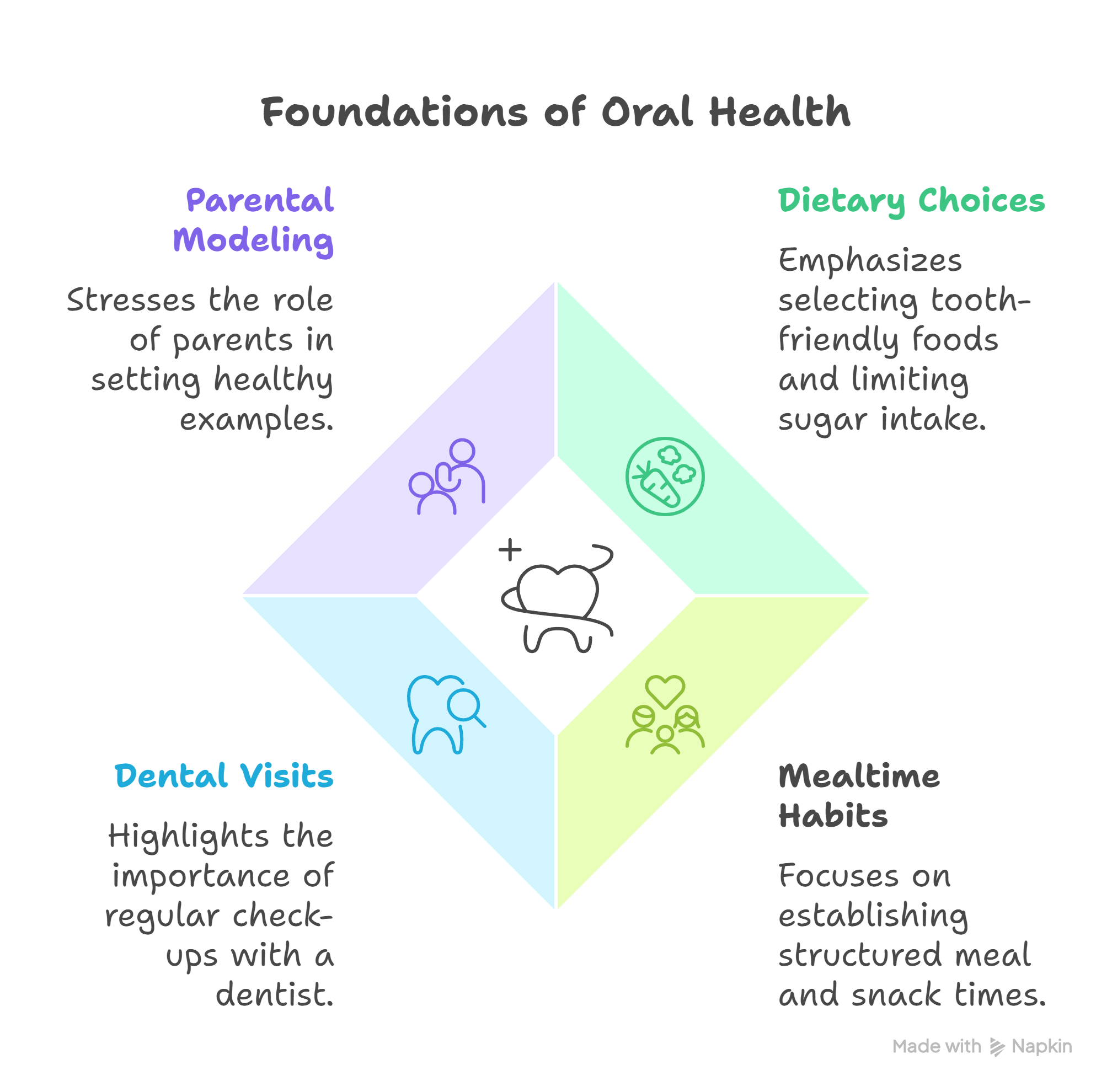Imagine a bustling, microscopic city thriving inside your child’s mouth. This isn’t science fiction; it’s their oral microbiome – a complex community of bacteria, fungi, and other microorganisms that plays a pivotal role in their overall health, especially their dental well-being. For parents, understanding this hidden world is the first step in safeguarding their child’s smile from a common but preventable threat: Early Childhood Caries (ECC). You might think cavities are just about “too much sugar,” but the story is far more intricate. It’s about how that sugar interacts with the unique ecosystem developing in your child’s mouth, shaping its future for health or disease.
Let’s explore how thoughtful dietary choices can be your child’s first line of defense, nurturing a balanced microbiome that keeps those tiny teeth strong and healthy.
Understanding the Oral Microbiome and Early Childhood Caries
Think of your child’s mouth as a garden. Just like any garden, it can flourish with a diverse array of healthy plants, or it can be overtaken by weeds. In this case, the “plants” are the bacteria in their oral microbiome.

A healthy balance means a vibrant garden; an imbalance, known as dysbiosis, means certain “weeds” – harmful, acid-producing bacteria – can take over.
Early Childhood Caries (ECC), often referred to as baby bottle tooth decay or rampant childhood cavities, is a severe form of tooth decay affecting infants and young children.
It’s more than just a little cavity; it’s a destructive process that can impact primary (baby) teeth, leading to pain, infection, difficulty eating, and even speech problems.
These primary teeth are crucial placeholders for permanent teeth, so their health truly matters.
How Diet Disrupts the Balance
The primary “fuel” for the harmful bacteria in the oral microbiome is fermentable carbohydrates – yes, sugar, but also starches found in many processed foods. When these bacteria consume carbohydrates, they produce acids.
These acids then attack the tooth enamel, leading to a drop in the mouth’s pH level.
This dip below a “critical pH” (typically around 5.5) creates an acidic environment where tooth enamel begins to demineralize, meaning it loses vital minerals like calcium and phosphate.
Over time, repeated acid attacks overwhelm the mouth’s natural ability to remineralize (repair) the enamel, leading to the formation of cavities.
The key isn’t just how much sugar or fermentable carbohydrates your child consumes, but how often and for how long their teeth are exposed.
Frequent snacking, prolonged bottle use, or sipping on sugary drinks keeps the pH low, essentially bathing the teeth in acid and giving harmful bacteria constant fuel.
The Sweet Truth: How Diet Fuels (or Fights) Cavities
The direct link between diet and ECC is undeniable. Research from the National Institutes of Health (NIH) highlights that both the quantity and frequency of fermentable carbohydrate intake are major risk factors.
It’s not just about candies and sodas; natural sugars in fruit juices, dried fruits, and even milk (lactose) can contribute to acid production if exposure is constant.
Beyond Obvious Sugars: Hidden Culprits and Critical pH
Many parents are diligent about avoiding obvious sweets, but often overlook “hidden sugars” and fermentable carbohydrates in seemingly healthy foods.
Yogurts with added fruit, breakfast cereals, fruit pouches, and even some baby foods can contain significant amounts of sugar that feed harmful oral bacteria.
The concept of critical pH is crucial. Each time your child consumes something sugary or starchy, the pH in their mouth drops. It takes about 20-30 minutes for saliva to neutralize these acids and help remineralize the enamel.
Frequent snacking or sipping means the mouth spends more time below that critical pH, making it harder for teeth to repair themselves.
This is why a structured meal and snack schedule is often more protective than allowing children to graze frequently, even on seemingly healthy items like fruit.
While whole fruits are nutritious, constant exposure to their natural sugars can still be problematic for dental health.
The Canadian Paediatric Society (CPS) advises limiting fruit juice due to its concentrated sugar content and acidity, recommending whole fruit instead.
Your Age-by-Age Guide: Nurturing a Healthy Oral Microbiome
Protecting your child’s oral microbiome begins even before their first tooth emerges. Different developmental stages come with unique dietary considerations and habits.
Infants (0-12 Months): Building the Foundation
This is a critical period for establishing a healthy oral microbiome.
- Maternal Influence: The mother’s oral health and diet during pregnancy and infancy can influence the child’s developing microbiome. Maintaining good oral hygiene during pregnancy helps reduce the transmission of cariogenic (cavity-causing) bacteria to the baby.
- Breastfeeding & Formula: Breast milk provides antibodies and nutrients crucial for infant health. While it contains lactose (a sugar), breastfeeding itself is not a direct cause of ECC unless combined with poor oral hygiene and prolonged, on-demand night feeding after teeth have erupted, especially if milk pools in the mouth. Similarly, formula contains sugar. Always ensure proper cleaning of your infant’s gums and emerging teeth.
- Water, Not Sweet Drinks: Introduce water with solids. Avoid giving infants juice, sugary drinks, or even diluted juice in bottles or sippy cups.
- No Bottle Propping: Never prop a bottle for your infant, especially at bedtime or naptime. This allows milk or formula to pool around the teeth, increasing the risk of ECC.
- Pacifier Hygiene: Ensure pacifiers are clean. Avoid dipping them in honey or sugar, which can introduce harmful bacteria and sugars to the mouth.
- First Solids (Around 6 Months): Introduce a variety of plain, unsweetened foods. Focus on vegetables, fruits (pureed or soft), iron-fortified cereals mixed with water or breast milk/formula. Avoid foods with added sugars, refined grains, and sticky textures.
Toddlers (1-2 Years): Navigating New Tastes & Habits

Toddlers are exploring new foods and developing independence, which can present new challenges for oral health.
- Transition to Cups: By age 1, encourage your child to drink from a cup and phase out bottles. Sippy cups should be used for short periods with water, not for constant sipping throughout the day, particularly with sugary drinks or milk.
- Structured Mealtimes & Snacks: Establish regular meal and snack times to limit continuous acid attacks. Aim for three main meals and one to two healthy snacks a day. Avoid constant grazing.
- Non-Cariogenic Snack Ideas: Offer snacks that are tooth-friendly. Great options include:
- Cheese (stimulates saliva, contains calcium and phosphate)
- Plain yogurt (no added sugar)
- Fresh vegetables (carrots, cucumber slices)
- Hard-boiled eggs
- Small portions of whole fruit (apples, berries – but again, not constantly)
- Whole grain crackers with cheese
- Beware of Hidden Sugars: Carefully read food labels. Sugars can be listed as glucose, fructose, sucrose, corn syrup, high-fructose corn syrup, dextrose, maltose, etc. Limit foods where sugar is one of the first few ingredients.
- First Dental Visit: The American Academy of Pediatric Dentistry (AAPD) recommends a child’s first dental visit by age one or when their first tooth appears. This initial visit helps establish a “dental home” and provides personalized guidance on preventive measures, including dietary advice.
Preschoolers (2-5 Years): Empowering Healthy Choices
As preschoolers gain more independence, teaching them about healthy choices becomes paramount.
- Healthy Lunchbox Ideas: If your child attends daycare or preschool, pack tooth-friendly lunches and snacks. Include water, cheese, lean proteins, vegetables, and whole fruits. Limit fruit snacks, sugary cereals, and juice boxes.
- Managing Social Sweets: It’s unrealistic to completely eliminate all sugary treats. The key is moderation and timing. If your child has a treat, serve it with a meal rather than as a standalone snack. The increased saliva production during meals helps wash away sugars and neutralize acids. Always follow with water and brushing, if possible.
- Saliva-Stimulating Foods: Foods that require chewing, like crunchy vegetables (carrots, celery) and fibrous fruits, help stimulate saliva flow. Saliva is your mouth’s natural defense against cavities, as it washes away food particles, neutralizes acids, and contains minerals that help remineralize enamel.
- Parental Role Modeling: Children learn by example. When parents make healthy food choices and prioritize dental hygiene, their children are more likely to adopt similar habits.
- Regular Dental Check-ups: Consistent visits to a pediatric dentist are vital for monitoring oral health, applying fluoride treatments, and receiving professional cleanings. These visits are a cornerstone of preventing ECC and ensuring your child’s developing smile stays healthy. Explore more about pediatric dentistry services designed for children.
Beyond Diet: Holistic Care for a Happy Mouth
While diet is a cornerstone, it’s part of a larger strategy for optimal oral health.
- Effective Oral Hygiene: Brushing twice a day with fluoride toothpaste (a tiny smear for children under 3, a pea-sized amount for ages 3-6) and flossing daily are non-negotiable.
- Fluoride’s Role: Fluoride strengthens enamel and helps resist acid attacks. Your dentist can advise on appropriate fluoride exposure through toothpaste, fluoridated water, and professional applications.
- Regular Dental Visits: These appointments allow dental professionals to monitor your child’s oral development, provide cleanings, and apply sealants to protect molars. Our team of experienced dental professionals at Smile Makers Dental Care, led by Dr. Seema Shetty, is dedicated to providing personalized and comprehensive care. You can learn more about us and our approach to patient comfort and quality care on our About Us page.
Your Child’s Oral Microbiome: FAQ for Parents
Q1: What non-sugar foods actually feed beneficial oral bacteria?
A: While specific “good bugs” can be fed by a variety of foods, the general principle is to support a diverse, balanced diet rich in whole, unprocessed foods. Fermented foods (like plain yogurt with live cultures) can introduce beneficial bacteria, but their direct long-term impact on the oral microbiome needs more research. Crunchy, fibrous fruits and vegetables help clean teeth and stimulate saliva, which in turn helps maintain a healthy oral environment. Cheese, with its calcium, phosphate, and ability to stimulate saliva, is particularly beneficial for buffering acids.
Q2: How do specific probiotics or prebiotics work in the oral microbiome for ECC prevention?
A: Research into specific oral probiotics (beneficial bacteria strains) and prebiotics (compounds that feed beneficial bacteria) for ECC prevention is ongoing. Some studies show promise for certain strains in reducing levels of cavity-causing bacteria. However, current recommendations focus more on broader dietary strategies and hygiene. Always consult your dentist or pediatrician before introducing specific probiotic supplements for oral health.
Q3: What are practical, healthy snack alternatives for common sugary items?
A: Instead of cookies, offer whole-grain crackers with cheese. Swap fruit juice for water or plain milk (in moderation). Replace sugary yogurts with plain yogurt mixed with a few fresh berries. Instead of fruit snacks or gummy candies, offer small portions of whole fresh fruit or vegetable sticks. Remember, the timing of the snack is as important as the snack itself.
Q4: How can I manage dietary changes for children with strong preferences for sugary foods, especially in social settings?
A:
Lead by Example: Model healthy eating habits yourself.
- Offer Choices: Instead of saying “no,” offer two healthy alternatives.
- Involve Them: Let children help prepare healthy snacks or choose fruits and vegetables at the store.
- Educate Simply: Explain in child-friendly terms why some foods are “sometimes foods” (e.g., “sugar makes tiny bugs in our mouth grumpy”).
- Focus on Balance: Don’t forbid all treats; instead, incorporate them sparingly during mealtimes.
- Communicate with Caregivers: Talk to family, friends, and teachers about your child’s dietary guidelines.
- Be Patient: Changing habits takes time and consistency.
Q5: Are there specific cultural dietary practices that inadvertently increase ECC risk, and how can they be adapted?
A: Yes, certain cultural practices, while well-intentioned, can inadvertently increase ECC risk. Examples include:
- Sweetened Pacifiers/Dipping in Honey: Common in some cultures, this provides constant sugar exposure.
- Frequent Sweet Teas/Drinks: Offering toddlers sweet tea throughout the day.
- Sweetened Porridges/Baby Foods: Adding sugar or honey to infant foods.
- Extended Use of Bottles with Milk/Juice: Beyond infancy, or as a comfort item at night.
Adaptations involve understanding the cultural significance and offering healthier alternatives or modifying the frequency. For example, use unsweetened alternatives, offer plain water, and shift sweet treats to mealtime rather than continuous sipping. Respectful education and offering practical, culturally sensitive solutions are key.
Your Family’s Oral Microbiome Action Plan
Protecting your child’s oral microbiome is a journey, not a destination.
By understanding the science behind their tiny oral ecosystem and making informed dietary choices, you’re not just preventing cavities – you’re building a foundation for lifelong oral and overall health.
Remember:
- Balance is Key: Focus on a diverse diet rich in whole foods.
- Timing Matters: Limit snacking and sugary liquid exposure.
- Be a Label Detective: Uncover hidden sugars in processed foods.
- Hydrate with Water: Make water the primary beverage.
- Team Up with Professionals: Regular dental check-ups are essential.
If you have concerns about your child’s oral health or specific dietary questions, don’t hesitate to consult with your dentist. They are your best resource for personalized advice and care, helping you keep your child’s smile bright and healthy.




